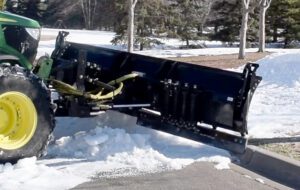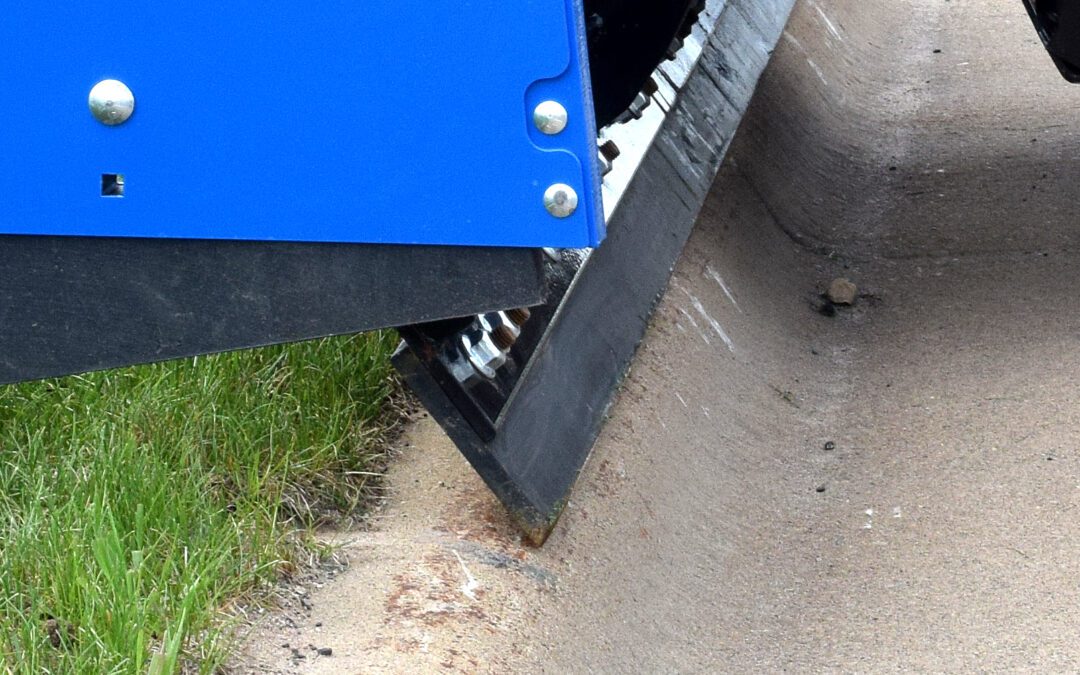If you’ve ever plowed snow, you know that there are dangers lurking underneath that glistening white blanket. That includes curbs, speed bumps, manholes and even objects left behind don’t belong on the road, driveway, sidewalk or parking lot. Those obstacles impede safety of the equipment and driver as well as the quality of snow clearing. That’s where trip edge plows come into play.
What is a snow plow trip edge?
 A snow plow trip edge, is a mechanism on the cutting edge of a plow moldboard that allows the cutting edge to “break away” when it comes in contact with an immoveable object. It is designed to “trip” in order prevent damage to the plow and the object it hits by reducing the force of the blow and allowing the plow to travel over the object.
A snow plow trip edge, is a mechanism on the cutting edge of a plow moldboard that allows the cutting edge to “break away” when it comes in contact with an immoveable object. It is designed to “trip” in order prevent damage to the plow and the object it hits by reducing the force of the blow and allowing the plow to travel over the object.
It is also helpful for the plow operator as it prevents his or her machine from coming to a sudden stop when it hits these unforeseen objects. (For all you basketball players out there, a “kiss off the glass” is not something you look forward to when plowing snow.)
Don’t confuse a trip edge with a full trip moldboard – where the whole moldboard trips. Trip edges are designed for low-lying obstacles and allow you to keep pushing snow, even when they trip. Full trip moldboards dump the entire load of snow when the entire moldboard trips forward.
How big is a trip edge?
 All KAGE snow plows and pushers are trip edge plows. These trip edges include both the base angle and the cutting edge. KAGE trip edges are either 8 or 9 inches tall and up to 10 feet in length.
All KAGE snow plows and pushers are trip edge plows. These trip edges include both the base angle and the cutting edge. KAGE trip edges are either 8 or 9 inches tall and up to 10 feet in length.
8-inch-tall trip edges are standard on the SnowFire, SnowFire BLAST and ShadowBlade moldboards. These both include 6-inch-tall cutting edges.
9-inch-tall trip edges are standard on both the SnowStorm and SnowDozer moldboards, which both utilize 8-inch-tall cutting edges.
These heights are critical to ensure that the moldboard will continue to travel over curbs when the trip edge activates. (The standard curb height is 6 inches.)
Length of a trip edge gets a little more complicated as it depends on the width of the plow. Plows with up to 10 feet can utilize a single trip edge. However, those longer than 10 feet will utilize a split trip edge. Limiting the length of the trip edge is critical to ensuring that the cutting edge and base angle do not get damaged from twisting or bending. While pressure in the center of an edge is generally pretty uniform, catching a corner can cause undue stress on the plow, if the edge is too long.
Take, for example, KAGE’s smallest plows – the SnowFire and SnowFire BLAST. Available in 6-, 8-, 9-, 10- and 12-foot lengths, these plows feature a single trip edge for all plows 10 feet and less. The 12-foot versions, however, will have a dual or split trip edge, meaning it is divided into two sections that can trip separately.
The next size up is the SnowStorm 2-in-1 plow system with 10-, 12- and 14-foot lengths, which all feature a dual trip edge.
And the largest system, the SnowDozer, available in 12-, 14-, 16-, 18- and 20-foot lengths will all feature split trip edges.
How much pressure does it take to activate a trip edge plow?
The size of the plow does have an effect on the force it takes to activate the trip edge. This is, in part, due to the size and thickness of the cutting edge and how much snow the plow needs to push.
For 6-to-10-foot lengths of SnowFire plows, it takes 510 ft/lbs to activate the trip. In cases where additional resistance to tripping is needed, KAGE does offer an additional spring option to increase that resistance. Speak with KAGE representative if this is something you desire.
The SnowStorm, on the other hand, requires 860 ft/lbs to trip the edge, which is why even the 10-foot edge is split.
How far does a trip edge fold back?
 The angle of the trip edge is important because you want to make sure it trips back far enough to prevent damage. With a 65-degree attack angle, any trip less that 25 degrees keeps the cutting edge pointing forward, meaning it will continue to cause damage.
The angle of the trip edge is important because you want to make sure it trips back far enough to prevent damage. With a 65-degree attack angle, any trip less that 25 degrees keeps the cutting edge pointing forward, meaning it will continue to cause damage.
- SnowFire & SnowFire BLAST = 68.5-degrees
- SnowStorm = 90 degrees
- SnowDozer = 90 degrees
Does the trip edge rebound?
 Yes. KAGE trip edges will return to their original position once they have passed the obstacles. This is achieved through the use of compression springs. These durable compression springs are designed to last significantly longer than extension springs, keeping the pressure consistent over time, rather than weakening with each use and causing excessive tripping.
Yes. KAGE trip edges will return to their original position once they have passed the obstacles. This is achieved through the use of compression springs. These durable compression springs are designed to last significantly longer than extension springs, keeping the pressure consistent over time, rather than weakening with each use and causing excessive tripping.



Recent Comments